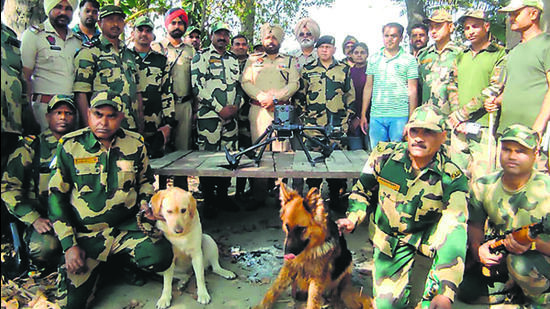BSF canine recruits are drones’ worst enemies
The fact that the dogs have been able to sense drones in the darkness (most are sent late at night or early in the morning, under cover of darkness) is a bonus.
Man’s best friend, it turns out, is also a drone’s worst enemy, for their keen ears can pick up the mechanical buzzing of these flying machines, a sound that the human ear usually doesn’t.

Just ask Jackie and Sultan.
The two dogs are part of the Border Security Force (BSF) in Punjab, which has used them to good effect to alert them to drones, usually carrying drugs or arms or cash (or all three) and usually sent from across the border with motives that are far from altruistic.
The fact that the dogs have been able to sense drones in the darkness (most are sent late at night or early in the morning, under cover of darkness) is a bonus.
With Jackie and Sultan’s success, BSF is training many other dogs. Officials in the force (who asked not to be named) said it is imperative to train more dogs, given the increasing menace of smugglers and terrorists from Pakistan sending weapons and drugs into Punjab using drones. On Sunday, at least seven drones were shot down by the force at the Amritsar, Gurdaspur and Fazilka border villages, the highest single-day recovery of drones to date.
Drones are a big problem across the 553km long border Punjab shares with Pakistan. Last year, a total of 107 drones, most carrying drugs or arms, were recovered; this year, the number has already reached 72. Drones were also used in the June 27, 2021, attack on the Indian Air Force station in Jammu.
BSF now wants to use dogs against drones in the Jammu and the Rajasthan sector, where drones, though not as common as in the Punjab sector, are used to drop drugs and weapons.
With the drones flown only after sunset – most commonly between 8pm and midnight – making them difficult to spot, trained dogs such as Sultan and Jackie, both labrador retrievers, come in handy. Officials said the two dogs were trained at BSF’s National Training Centre for Dogs (NTCD) in Tekanpur, Gwalior, one of the oldest dog training academies in the country.
“Anti-drone devices are there at only a few places and that too on experimental basis. Most times our personnel fire at least two dozen to a hundred bullets to shoot down the drone. But the dogs immediately alert us whenever a drone enters our side of the border,” said one of the officials cited above.
The force also uses different sniffer dogs from its K9 unit to trace drugs or explosives dropped by the drones in the field.
But Sultan and Jackie have shown that trained dogs can do better.
“Sultan and Jackie have successfully detected at least nine drones in the air,” the official added.
Atul Fulzele, inspector general of BSF’s Punjab frontier said: “The dogs in our Amritsar sector are trained to hear the humming sound of the drone. Many more dogs are under training. The trained dogs, along with our vigilant guards and the gadgets we have are helping us detect drones. On Sunday, our sector seized at least seven drones in one day. Our force is equipped and adequately responds to the menace of drones.”
This year, terrorists have also sent across powerful guns such as AK-47 using drones. Over the last two years, weapons smuggled by drones from Pakistan been linked to many terror cases such as the murder of Punjab singer Sidhu Moosewala and the December 21, 2023, terror attack in Jammu where four army personnel were killed.
Another of the officials cited in the first instance said that the dogs will be more useful during the winters when there is dense fog . “Movement of drones increases when there is fog. The drones are fitted with GPS so they drop the consignment at the pre-decided location within 500-800m from border fence and return.”






